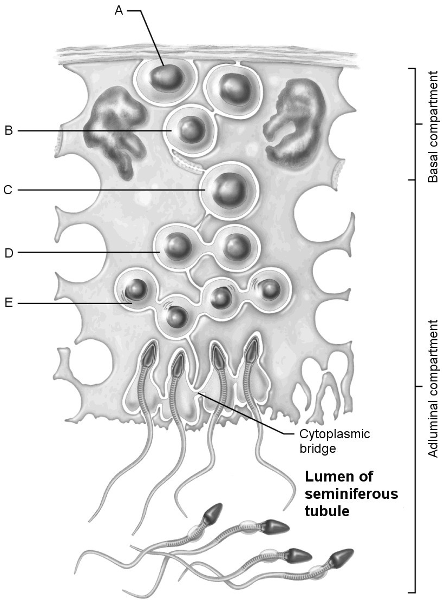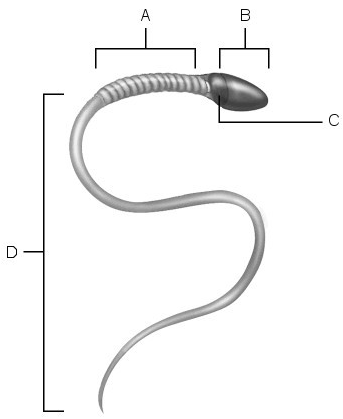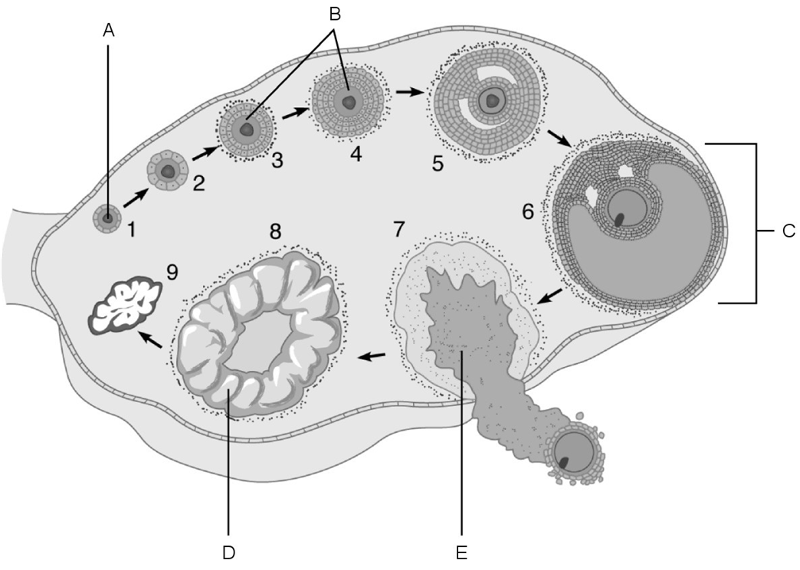Instructions for Side by Side Printing
- Print the notecards
- Fold each page in half along the solid vertical line
- Cut out the notecards by cutting along each horizontal dotted line
- Optional: Glue, tape or staple the ends of each notecard together
Chapter 27
front 1  1) Stem cell. | back 1 1. A 2. D 3. B 4. E 5. C |
front 2  6) Acrosome. | back 2 1. B 2. A 3. A 4. C 5. C 6. D |
front 3  12) The stage called ovulation. | back 3 12. E 13. C 14. B 15. A 16. D 17. C |
front 4 1) The dartos and cremaster muscles are important to the integrity of
the male reproductive | back 4 B) They regulate the temperature of the testes. |
front 5 2) The ability of sperm cells to move along the ductus deferens is
due to ________. | back 5 B) peristaltic contractions |
front 6 3) The ability of a male to ejaculate is due to the action of ________. | back 6 D) the bulbospongiosus muscles |
front 7 4) The most important risk for testicular cancer in young males is ________. | back 7 C) nondescent of the testes |
front 8 5) Which of the following glands are responsible for 60% of the synthesis of semen? | back 8 C) the prostate |
front 9 6) Which of the following hormones controls the release of anterior pituitary | back 9 C) GnRH |
front 10 7) Development of male reproductive structures depends on which of the following events? | back 10 C) secretion of male hormones prenatally and lasting into the first few months after birth |
front 11 8) The primary function of the uterus is to ________. | back 11 D) receive, retain, and nourish a fertilized ovum |
front 12 9) Why is the bloodtestis | back 12 A) because spermatozoa and developing cells produce surface antigens
that are recognized |
front 13 10) The structures that receive the ovulated oocyte, providing a site
for fertilization, are | back 13 B) fallopian tubes |
front 14 11) If gametes were diploid like somatic cells, how many chromosomes
would the zygote | back 14 A) twice the diploid number, and with every succeeding generation,
the chromosome |
front 15 12) Human egg and sperm are similar in that ________. | back 15 C) they have the same number of chromosomes |
front 16 13) The constancy of the chromosome number from one cell generation
to the next is | back 16 B) meiosis |
front 17 14) Fertilization generally occurs in the ________. | back 17 D) fallopian tubes |
front 18 15) Spermiogenesis involves the ________. | back 18 C) formation of a functional sperm by the stripping away of superfluous cytoplasm |
front 19 16) All of the following can be considered male secondary sex
characteristics except the | back 19 C) development of testes as opposed to ovaries |
front 20 17) In humans, separation of the cells at the twocell | back 20 B) identical |
front 21 18) Characteristics of the mature sperm include the ________. | back 21 B) presence of Y chromosomes in approximately half the sperm |
front 22 19) How do the testes respond to exposure to excessive body warmth? | back 22 B) They move away from the pelvic cavity. |
front 23 20) Effects of estrogen include ________. | back 23 C) growth of the breasts at puberty |
front 24 21) Secretion of progesterone stimulates ________. | back 24 B) preparation of the mammary glands for lactation |
front 25 22) Which of the following statements about sperm is not true? | back 25 B) They are sluggish in an alkaline environment. |
front 26 23) The cells that produce testosterone in the testis are called ________. | back 26 D) interstitial cells |
front 27 24) The testicular cells that construct the bloodtestis | back 27 C) sustentacular cells |
front 28 25) Which of the following occurs as a result of undescended testes? | back 28 C) Inadequate or nonviable sperm will be produced. |
front 29 26) Erection of the penis results from ________. | back 29 D) a parasympathetic reflex |
front 30 27) Which is not a part of the proliferative phase of the female menstrual cycle? | back 30 C) corpus luteum |
front 31 28) Which of the choices below is not a function of the vagina? | back 31 A) serves as a passageway for the primary oocyte |
front 32 29) Select the correct statement about male sexual response. | back 32 B) Erection is the result of vascular spaces in the erectile tissues filling with blood. |
front 33 30) Which of the choices below is not a function of testosterone? | back 33 D) stimulates mammary gland development |
front 34 31) Which male hormone inhibits the secretion of FSH? | back 34 B) inhibin |
front 35 32) During the secretory phase of the menstrual cycle ________. | back 35 B) progesterone levels are at their highest |
front 36 33) Select the correct statement about the uterine cycle. | back 36 D) If fertilization occurs, the corpus luteum is maintained by a
hormone secreted by the |
front 37 34) Which of the choices below is not a part of the braintesticular | back 37 C) thalamus |
front 38 35) Which of the following statements is true concerning the mammary
glands of both males | back 38 D) The mammary glands are modified sweat glands that are actually
part of the |
front 39 36) Normally menstruation occurs when ________. | back 39 B) blood levels of estrogen and progesterone decrease |
front 40 37) The basic difference between spermatogenesis and oogenesis is that ________. | back 40 C) in oogenesis, one mature ovum is produced, and in spermatogenesis
four mature sperm |
front 41 38) Occasionally three polar bodies are found clinging to the mature
ovum. One came from | back 41 C) The first polar body has also divided to produce two polar bodies. |
front 42 39) Which of the following will occur after ovulation? | back 42 B) The endometrium enters its secretory phase |
front 43 40) Why doesn’t semen enter the urinary bladder during ejaculation? | back 43 C) The smooth muscle sphincter at the base of the urinary bladder closes. |
front 44 41) Spermatogenesis ________. | back 44 B) involves a kind of cell division limited to the gametes |
front 45 42) Which hormone is absolutely necessary for ovulation to occur? | back 45 A) LH |
front 46 43) The braintesticular | back 46 B) involves FSH and LH release |
front 47 44) Select the correct statement about testosterone control. | back 47 A) GnRH from the hypothalamus causes FSH and LH release from the anterior pituitary. |
front 48 45) Which of the following is a correct statement about uterine tubes? | back 48 B) The infundibulum is the funnelshaped |
front 49 46) Select the correct statement about the hormonal events of the ovarian cycle. | back 49 B) High estrogen levels result in a surge of LH release. |
front 50 47) Which of these statements about sexually transmitted infections
is false? | back 50 C) Syphilis is caused by a virus that may lead to death if untreated. |
front 51 48) Which of the following statements about spermatogenesis is not true? | back 51 D) Each spermatid forms two sperm. |
front 52 49) A boy who has not passed through puberty sustains an injury to
his anterior pituitary | back 52 A) be sterile |
front 53 50) Which of the following statements about the female reproductive process is not true? | back 53 C) Rebuilding the endometrium is under the control of prolactin. |
front 54 51) A low secretion of luteinizing hormone (LH) in the normal male
adult would cause | back 54 A) decreased testosterone secretion |
front 55 52) All of the following statements referring to the uterine cycle are true except ________. | back 55 A) FSH and LH directly promote development of the uterine endometrium |
front 56 3) Which of the following phases or processes in the monthly
reproductive cycle of the | back 56 D) regression of the corpus luteum and a decrease in ovarian progesterone secretion |
front 57 54) The duct system of the male reproductive system does not include the ________. | back 57 D) corpus spongiosum |
front 58 55) An ovulating oocyte is actually activated by hormones about
________ days before | back 58 D) 110 |
front 59 56) Prostate cancer is _______. | back 59 B) sometimes a slow growing cancer that may never represent a threat to the patient |